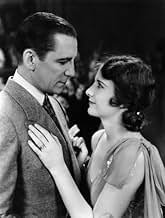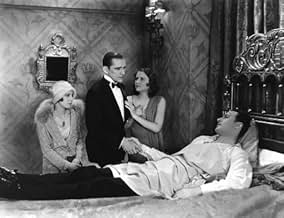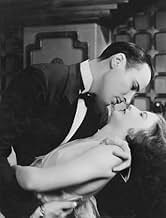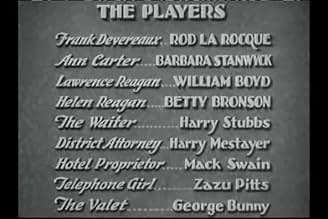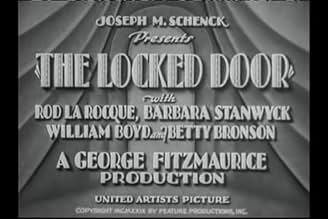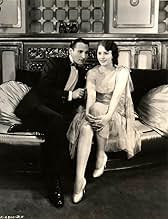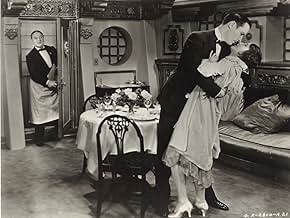CALIFICACIÓN DE IMDb
6.0/10
625
TU CALIFICACIÓN
Agrega una trama en tu idiomaOn her first anniversary Ann Reagan finds that her sister-in-law is involved with a shady character from her own past, and determines to intervene.On her first anniversary Ann Reagan finds that her sister-in-law is involved with a shady character from her own past, and determines to intervene.On her first anniversary Ann Reagan finds that her sister-in-law is involved with a shady character from her own past, and determines to intervene.
- Dirección
- Guionistas
- Elenco
Zasu Pitts
- Telephone Girl
- (as Zazu Pitts)
Mary Ashcraft
- Girl on Rum Boat
- (sin créditos)
Violet Bird
- Girl on Rum Boat
- (sin créditos)
Earle Browne
- Bit Part
- (sin créditos)
Clarence Burton
- Police Officer
- (sin créditos)
Lita Chevret
- Girl on Rum Boat
- (sin créditos)
Gilbert Clayton
- Bit Part
- (sin créditos)
Pauline Curley
- Bit Part
- (sin créditos)
Edgar Dearing
- Cop
- (sin créditos)
Edward Dillon
- Bit Part
- (sin créditos)
Opiniones destacadas
The attraction here is not just Barbara Stanwyck, even though it's her first talkie and she handles her role with a secure professionalism that belies her cinematic inexperience. Born for the camera she was! But an equally impressive performance is delivered by Rod La Rocque as the serial cad who mistreats her and then sets his sights on her younger sister. The trappings are typical 20's soap opera/melodrama, in this case derived from a stage play. But not typical for the era is La Rocque's well-tailored villain who seems to have stepped out of a story from a much later era; in fact, his performance would not be considered one bit dated even by today's standards - highly unusual for a film from 1929. His line readings and body language bespeak a decadent, spoiled rogue without a scintilla of conscience, all of this enhanced by delicately tapered sideburns. He also has a smooth, deep speaking voice. The look and style of the film are standard for the era but include an interesting, lively panoramic dance party sequence on a "drinking boat" (pleasure boats that sailed outside the 12-mile limit of the US coast so the patrons could drink alcohol illegally during the Prohibition era) intercut with an intimate scene between Stanwyck and La Rocque in one of the cabins.
Locked Door, The (1929)
** (out of 4)
Dry crime melodrama about a woman (Barbara Stanwyck) who gets herself arrested while on a rum boat with the lavish Frank Devereaux (Rod La Rocque). Eighteen months later she is married to another man (William Boyd) but she soon learns that his sister is now involved with Frank. This early talkie from United Artist has pretty much been forgotten with the exception that it will stand the test of time as being Stanwyck's first major role as her previous film had her in a bit role. As with many early talkies, the technology leaves a lot to be desired and I can't help but think that the director wasn't too worried with what was happening on the screen as he was making sure everyone could hear what was going on. The film is incredibly dry of any humor, suspense or drama and that's a real shame because the story is actually pretty good as all four characters get involved with a possible murder towards the end of the film. This murder happens an hour into a 74-minute film so the payoff comes rather quickly but the ending is certainly the best thing about the movie. Stanwyck comes off fairly good in her role but there's no doubt she still had some rust around the edges. La Rocque comes off incredibly over the top as if he was playing in some sort of strange comedy and I can only compare him to what people would see decades later in John Waters. Boyd is pretty good in his role and actually steals the film, although Zasu Pitts has a few good scenes as a telephone operator.
** (out of 4)
Dry crime melodrama about a woman (Barbara Stanwyck) who gets herself arrested while on a rum boat with the lavish Frank Devereaux (Rod La Rocque). Eighteen months later she is married to another man (William Boyd) but she soon learns that his sister is now involved with Frank. This early talkie from United Artist has pretty much been forgotten with the exception that it will stand the test of time as being Stanwyck's first major role as her previous film had her in a bit role. As with many early talkies, the technology leaves a lot to be desired and I can't help but think that the director wasn't too worried with what was happening on the screen as he was making sure everyone could hear what was going on. The film is incredibly dry of any humor, suspense or drama and that's a real shame because the story is actually pretty good as all four characters get involved with a possible murder towards the end of the film. This murder happens an hour into a 74-minute film so the payoff comes rather quickly but the ending is certainly the best thing about the movie. Stanwyck comes off fairly good in her role but there's no doubt she still had some rust around the edges. La Rocque comes off incredibly over the top as if he was playing in some sort of strange comedy and I can only compare him to what people would see decades later in John Waters. Boyd is pretty good in his role and actually steals the film, although Zasu Pitts has a few good scenes as a telephone operator.
Other than the fact that this was Barbara Stanwyck's second film and talkie debut, believe me there isn't any other reason to remember The Locked Door. It's a rather turgid melodrama with some stock company heroes and villains. It might very well have been a play on the Cotton Blossom, but for its urban setting.
Barbara Stanwyck showed something in this film though, she wouldn't have had the career she had if she didn't. You can definitely spot the star quality with her.
The film is based on a Broadway play by Channing Pollock that ran 187 performances during the 1919-1920 season. The subject of Prohibition was new at that time, by 1929 it was old hat. In any event it's only part of the story.
Stanwyck and Snidely Whiplash villain Rod LaRocque are on a floating gambling and drinking boat when it's raided. They both jump bail and go their separate ways, Stanwyck thanking the Deity she had no further involvement with LaRocque.
But that's not what fate has in store for her. She marries William Boyd, a widower with daughter Betty Bronson. Guess who Bronson tells dear old Dad and step mom who she's involved with.
When both Stanwyck and Boyd go to confront LaRocque, but separately, that's when the action really starts.
One thing I will say in favor of the film, the camera work reminded me a whole lot of Alfred Hitchcock's famous one set films, Rear Window and Rope, because the story takes place in the last half in LaRocque's apartment. But the hammy acting and melodramatic plot date this film terribly.
Still Barbara Stanwyck's personality certainly stands out.
Barbara Stanwyck showed something in this film though, she wouldn't have had the career she had if she didn't. You can definitely spot the star quality with her.
The film is based on a Broadway play by Channing Pollock that ran 187 performances during the 1919-1920 season. The subject of Prohibition was new at that time, by 1929 it was old hat. In any event it's only part of the story.
Stanwyck and Snidely Whiplash villain Rod LaRocque are on a floating gambling and drinking boat when it's raided. They both jump bail and go their separate ways, Stanwyck thanking the Deity she had no further involvement with LaRocque.
But that's not what fate has in store for her. She marries William Boyd, a widower with daughter Betty Bronson. Guess who Bronson tells dear old Dad and step mom who she's involved with.
When both Stanwyck and Boyd go to confront LaRocque, but separately, that's when the action really starts.
One thing I will say in favor of the film, the camera work reminded me a whole lot of Alfred Hitchcock's famous one set films, Rear Window and Rope, because the story takes place in the last half in LaRocque's apartment. But the hammy acting and melodramatic plot date this film terribly.
Still Barbara Stanwyck's personality certainly stands out.
Someone referred to this as "stagy," and was more correct than perhaps he knew: "The Locked Door" was originally a stage play, and this movie was an adaptation, a good one in my opinion.
C. Gardner Sullivan had been writing scenarios and inter-titles since at least 1912, and is honored among aficionados who know his work from those earliest years of motion pictures.
The four top-billed players were also veterans, except for Barbara Stanwyck who has only one previous credit.
Rod La Rocque had been in movies since at least 1914, and put in 12 more years.
Betty Bronson became a huge star with her seventh role, Peter Pan in the movie of that name, and reportedly was chosen for the part by James M. Barrie, the author, himself.
William Boyd, known here at IMDb as "William 'Stage' Boyd," is the primary reason the Screen Actors Guild usually forbids a member having the same name as another, Harrison Ford being the only exception that comes immediately to my mind.
This particular Boyd was busted on something shameful and the picture of "the other" William Boyd, who later became very famous as Hopalong Cassidy, was published in a newspaper, almost destroying his career.
In this cast there are lots of "withs" who help make this a very good movie, including Mack Swain and Zasu Pitts.
The story is not really a mystery, at least not to us, because we see everything that happens, but it is a drama, with conflict and character change.
I'm reminded of the aphorism that people in small towns buy their local paper not to see who did what, because everyone knows, but to see who gets blamed.
That's the premise of this story, and it's well done, plausible by the standards of its time.
There is also a good point for modern society: Laws against consensual acts, such as gambling or ingestion of certain substances, in this case, alcohol, cause more problems than they solve.
"The Locked Door" is good cinema, especially for anyone who wants to watch the evolution of the art.
C. Gardner Sullivan had been writing scenarios and inter-titles since at least 1912, and is honored among aficionados who know his work from those earliest years of motion pictures.
The four top-billed players were also veterans, except for Barbara Stanwyck who has only one previous credit.
Rod La Rocque had been in movies since at least 1914, and put in 12 more years.
Betty Bronson became a huge star with her seventh role, Peter Pan in the movie of that name, and reportedly was chosen for the part by James M. Barrie, the author, himself.
William Boyd, known here at IMDb as "William 'Stage' Boyd," is the primary reason the Screen Actors Guild usually forbids a member having the same name as another, Harrison Ford being the only exception that comes immediately to my mind.
This particular Boyd was busted on something shameful and the picture of "the other" William Boyd, who later became very famous as Hopalong Cassidy, was published in a newspaper, almost destroying his career.
In this cast there are lots of "withs" who help make this a very good movie, including Mack Swain and Zasu Pitts.
The story is not really a mystery, at least not to us, because we see everything that happens, but it is a drama, with conflict and character change.
I'm reminded of the aphorism that people in small towns buy their local paper not to see who did what, because everyone knows, but to see who gets blamed.
That's the premise of this story, and it's well done, plausible by the standards of its time.
There is also a good point for modern society: Laws against consensual acts, such as gambling or ingestion of certain substances, in this case, alcohol, cause more problems than they solve.
"The Locked Door" is good cinema, especially for anyone who wants to watch the evolution of the art.
BARBARA STANWYCK was never too fond of her first talkie and it's easy to see why. Filmed at a time when stage actors were just getting familiar with sound technique in films, it has a multitude of problems with regard to script, direction and performances.
ROD LaROCQUE is insufferably hammy as the bad guy who tries to seduce Stanwyck aboard an illegal rum boat and turns up some eighteen months later paying court to her sister (BETTY BRONSON). Stanwyck and hubby WILLIAM BOYD decide to stop LaRocque from carrying through with his plans to run off with Bronson and the plot thickens, going from one melodramatic mess to another before the story crawls to an end.
Best aspect of the film is the photography of Ray June, especially the overhead shots looking through the glass ceiling of a dance floor on the riverboat and the panning shot of bar customers ordering drinks.
Everyone sounds like they're reading their lines for a run through rehearsal, but Stanwyck at least shows emotion well in some good close-ups. Bronson and LaRocque are the worst with the new mikes.
ROD LaROCQUE is insufferably hammy as the bad guy who tries to seduce Stanwyck aboard an illegal rum boat and turns up some eighteen months later paying court to her sister (BETTY BRONSON). Stanwyck and hubby WILLIAM BOYD decide to stop LaRocque from carrying through with his plans to run off with Bronson and the plot thickens, going from one melodramatic mess to another before the story crawls to an end.
Best aspect of the film is the photography of Ray June, especially the overhead shots looking through the glass ceiling of a dance floor on the riverboat and the panning shot of bar customers ordering drinks.
Everyone sounds like they're reading their lines for a run through rehearsal, but Stanwyck at least shows emotion well in some good close-ups. Bronson and LaRocque are the worst with the new mikes.
¿Sabías que…?
- TriviaOther than one bit part, this is Barbara Stanwyck's feature film debut.
- Citas
Ann Carter: You won't gain anything by keeping me here!
Frank Devereaux: Oh, I like you in a temper. I want to hold you close, knowing you don't want to be held.
- ConexionesFeatured in Visions of Light (1992)
- Bandas sonorasI've Got a Feeling I'm Falling
(uncredited)
Written by Fats Waller and Harry Link
First tune played on the boat
Selecciones populares
Inicia sesión para calificar y agrega a la lista de videos para obtener recomendaciones personalizadas
- How long is The Locked Door?Con tecnología de Alexa
Detalles
- Tiempo de ejecución1 hora 14 minutos
- Color
- Relación de aspecto
- 1.20 : 1
Contribuir a esta página
Sugiere una edición o agrega el contenido que falta

Principales brechas de datos
By what name was La puerta cerrada (1929) officially released in Canada in English?
Responda
